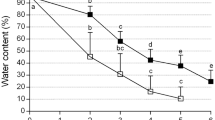Summary
A 20%–25% yield of isolated and living embryo sacs of Petunia hybrida L. was obtained using an enzymatic maceration mixture containing 3% driselase (soluble fraction only), 0.1% MES buffer, pH 5.5, and 8% mannitol. For each maceration ± 450 ovules were incubated in 1 ml enzyme solution for 2 h at 30° C in a shaking waterbath (150 rpm). Subsequently, the enzyme solution was replaced by Brewbaker and Kwack's medium, pH 6.5, supplemented with 10% mannitol (BKM). Gentle agitation of the suspension resulted in the liberation of embryo sacs, which were then collected with a micropipette using a dissecting microscope and transferred to fresh BKM. The embryo sacs isolated are intact and living, and have maintained their original shape and organization When stored in BKM at room temperature the isolated embryo sacs remain alive for 8 h. Storage at 4° C results in a prolongation of viability of up to 80 h. Prolonged incubation of ovules or reincubation of isolated embryo sacs in the maceration mixture results in the liberation of the gametophytic cells as individual, living protoplasts.
Similar content being viewed by others
References
Brewbaker JL, Kwack BH (1963) The essential role of calcium ion in pollen germination and pollen tube growth. Am J Bot 50:859–865
Cooper DC (1946) Double fertilization in Petunia. Am J Bot 33:54–57
Herr JM (1971) A new clearing-squash technique for the study of ovule development in angiosperms. Am J Bot 58:785–790
Heslop-Harrison J, Heslop-Harrison Y (1970) Evaluation of pollen viability by enzymatically-induced fluorescence: intracellular hydrolysis of fluorescein diacetate. Stain Technol 45:115–120
Hu S-Y, Li L-G, Zhou C (1985) Isolation of viable embryo sacs and their protoplasts of Nicotiana tabacum. Acta Bot Sin 27:337–344
Huang B-Q, Russell SD (1989) Isolation of fixed and viable eggs, central cells and embryo sacs from ovules of Plumbago zeylanica. Plant Physiol 90:9–12
Maheshwari P (1950) An introduction to the embryology of angiosperms. McGraw-Hill, New York
Meadows MG, Potrykus I (1981) Hoechst 33258 as a vital stain for plant cell protoplasts. Plant Cell Rep 1:77–79
Mol R (1986) Isolation of protoplasts from female gametophytes of Torenia fournieri. Plant Cell Rep 3:202–206
Van Went JL (1970a) The ultrastructure of the synergids of Petunia. Acta Bot Neerl 19:121–132
Van Went JL (1970b) The ultrastructure of the egg and central cell of Petunia. Acta Bot Neerl 19:313–322
Wagner VT, Kardolus JP, Van Went JL (1989a) Isolation of the lily embryo sac. Sex Plant Reprod 2:219–224
Wagner VT, Song YC, Matthys-Rochon E, Dumas C (1988) The isolated embryo sac of Zea mays: structural and ultrastructural observations. In: Cresti M, Gori P, Pacini E (eds) Sexual reproduction in higher plants. Springer, Berlin Heidelberg New York, pp 125–129
Wagner VT, Song YC, Matthys-Rochon E, Dumas C (1989b) Observations on the isolated embryo sac of Zea mays L. Plant Sci 59:127–132
Zhou C (1987) A study of fertilization events in living embryo sacs isolated from sunflower ovules. Plant Sci 52:147–151
Zhou C, Yang H-Y (1985) Observations on enzymatically isolated, living and fixed embryo sacs in several angiosperm species. Planta 165:225–231
Zhou C, Yang H-Y (1986) Isolation of embryo sacs by enzymatic maceration and its potential in haploid study. In: Hu S-Y, Yang H-Y (eds) Haploids of higher plants in vitro. Springer, Berlin Heidelberg New York, pp 192–203
Author information
Authors and Affiliations
Rights and permissions
About this article
Cite this article
Van Went, J.L., Kwee, HS. Enzymatic isolation of living embryo sacs of Petunia . Sexual Plant Reprod 3, 257–262 (1990). https://doi.org/10.1007/BF00202883
Issue Date:
DOI: https://doi.org/10.1007/BF00202883




